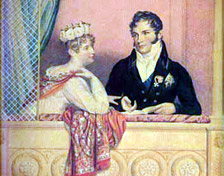This sprawling site is part of the personal website of Catherine Decker, author of scholarly work in several fields, including 18th-century gender and literature. The site contains more than 400 images of late 18th- and early 19th-century European fashions reproduced from fashion books of the period. The site also contains images of surviving items of clothing held by museums and private collectors; 18 reproduced portraits by European and American painters; material on the 1816 marriage of Princess Charlotte (daughter of Britain’s George IV) and Prince Leopold; and photographs of the Jane Austen Evening Tea and Ball held in California by the Lively Arts History Association.
The site is divided into eight main sections. The Real Regency Clothing Page contains images of surviving items from the period. Regency Fashion Plates, in which the images are arranged by fashion journal, and Regency Style Year by Year, which lists images chronologically, contain the bulk of the material on the site. A Regency Portraits Page provides images of notables of the period. The Men’s Page and Princess Charlotte’s Wedding Page provide images and information related to these themes and events. Kathy Hammel’s Regency Outerwear Article reproduces a short (1,500 word) article on this subject, and An Austen Evening reproduces photographs from modern reenactments of Regency social life. Below these sections are lists of specific clothing items or collections of clothing for a specific purpose, for example, Turbans or The Mourning Page.
There is a wealth of material on this site and it contains much of interest to students and teachers of Regency-period fashion and social life. A key disadvantage lies in the site’s unsystematic organization. It is clear the author is passionate about all aspects of her subject, and this leads her research in myriad directions creating a web of references and cross-references throughout the site. This is an unashamedly idiosyncratic website in which the author’s research and personal interests commingle. Some will find the site’s personal angle charming (re-enactment photographs of Californians in Regency costume jostle with selections from late 18th-century fashion books), but others will find it distracting.
For all its disadvantages, there is a wide range of fascinating material on this site that makes it useful for students and teachers interested in the social life and customs of the period. The distinctions between men’s and women’s dress are one obvious focus for discussion, as are the manner in which categories of dress (for example the distinction between undress, half dress, and full dress) reveal the activities and social attitudes of the period. There are snippets of information throughout the site about the context in which these fashions were worn, along with links to further reading associated with particular themes. Themes include individual artists in the portrait section and the list of research books in the Real Regency Clothing section.
Many users of this site will find the fashions interesting in themselves, but for those seeking to analyze dress within its social context, the following texts are recommended. Leonora Davidoff and Catherine Hall’s Family Fortunes: Men and Women of the English Middle Class, 1780 - 1850 is an unsurpassed classic.1 Their exploration of the relationship between class and gender in the making of the English middle class provides a useful background to discuss issues such as adornment, restraint, respectability, and gender roles with reference to dress and fashionable life. More recently, Cindy McCreery’s excellent study The Satirical Gaze: Prints of Women in Late Eighteenth-Century England provides an analysis of contemporary attitudes towards women (including their dress) as they were expressed through the voluminous popular print culture of the period.2
1 Leonora Davidoff and Catherine Hall, Family Fortunes: Men and Women of the English Middle Class, 1780 - 1850 (London: Hutchinson, 1987).
2 Cindy McCreery, The Satirical Gaze: Prints of Women in Late Eighteenth-Century England (Oxford: Oxford University Press, 2004).



